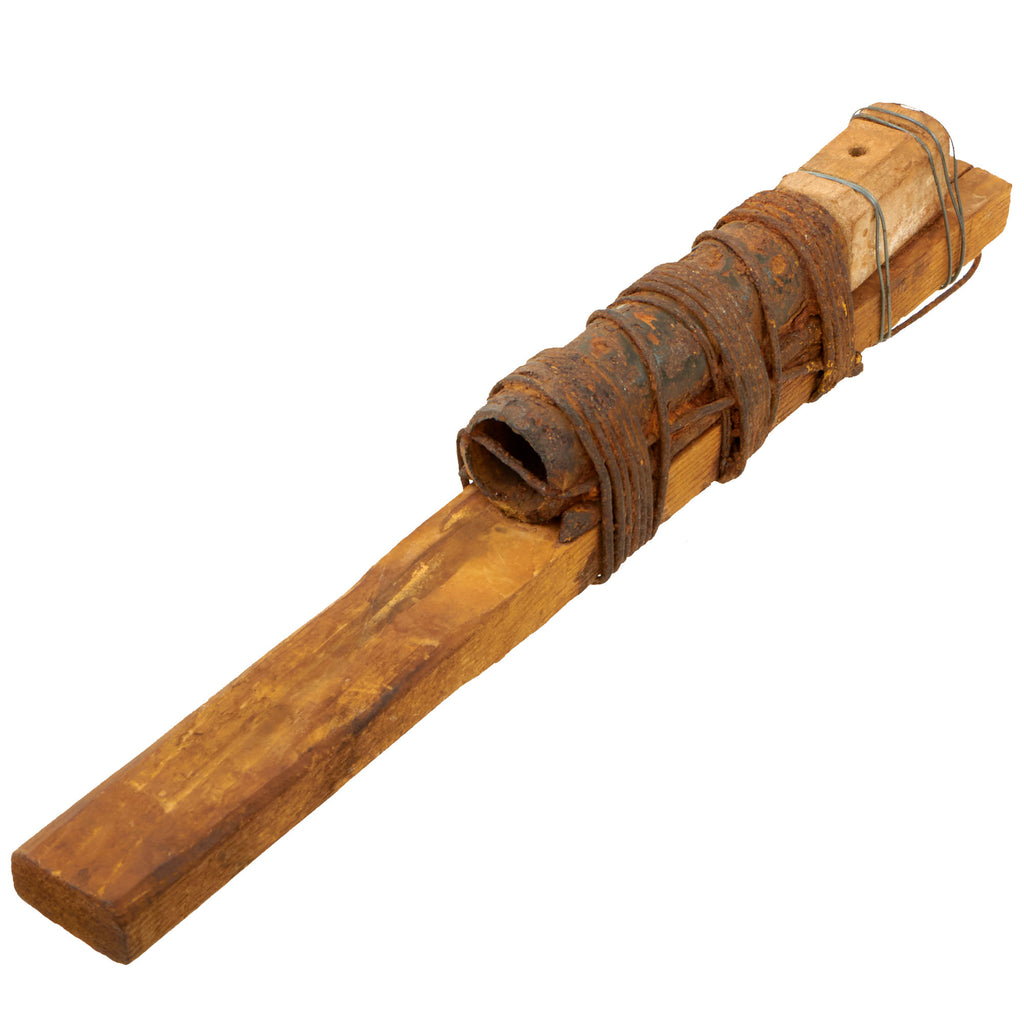Item Description
Original Item: Only One Available. This is a very nice French WWI IIIrd Army Stick Grenade (grenade de la troisième armée), which was basically an improvised design developed by factories during the first months of the war. These famous pétards or 'hairbrush grenades' were composed of a wooden paddle, cheddite explosive charge, and an explosive housing, often filled with nails or gravel. The design was made necessary by the low capacity of the French military armories to develop and manufacture more modern models of grenades rapidly enough to meet front line demand.
Unloaded or dummy grenades, artillery shell casings, and similar devices, which are cut or drilled in an BATF-approved manner so that they cannot be used as ammunition components for destructive devices, are not considered NFA weapons. This example is in total compliance and is NOT AVAILABLE FOR EXPORT.
More of a firework than a real grenade, it is composed of a long stick, with an attached steel tube designed for the insertion of a conventional mélinite 100g m1890 explosive charge with a detonator in its center.
The first examples were triggered by igniting a 5 second wick connected to the detonator tube. That system was soon improved upon by igniting the wick with two hunting ammunition primers placed in a small wooden block. The primers were triggered by a percussion on a nail introduced into a hole of the wooden block, pressing on a small metal piece connected to the starters base.
About 5 different types of cylinders of the same size were used, and various designs were used until 1917. Cheddite explosive would replace mélinite, each time that the demand exceeded the industrial capacity for modern grenades, which was unfortunately often.
Condition is quite good, though as with most battlefield recovered items, it does have rust and weathering wear. This example came to us as having been discovered in the earth in the area surrounding where the battle of Verdun took place. The wire on the top appears to have been replaced at some point after WW1. The device measures approximately at 13"L x 2 1/2" x 1 3/4".
The Battle of Verdun was fought from 21 February to 18 December 1916 on the Western Front in France. The battle was the longest of the First World War and took place on the hills north of Verdun-sur-Meuse. The German 5th Army attacked the defenses of the Fortified Region of Verdun and those of the French Second Army on the right (east) bank of the Meuse. Using the experience of the Second Battle of Champagne in 1915, the Germans planned to capture the Meuse Heights, an excellent defensive position, with good observation for artillery-fire on Verdun. The Germans hoped that the French would commit their strategic reserve to recapture the position and suffer catastrophic losses at little cost to the German infantry.
Poor weather delayed the beginning of the attack until 21 February but the Germans captured Fort Douaumont in the first three days. The advance then slowed for several days, despite inflicting many French casualties. By 6 March, 20+1⁄2 French divisions were in the RFV and a more extensive defense in depth had been organized. Philippe Pétain ordered there to be no retreat and that German attacks were to be counter-attacked, despite this exposing French infantry to the German artillery. By 29 March, French guns on the west bank had begun a constant bombardment of Germans on the east bank, causing many infantry casualties. The German offensive was extended to the west bank of the Meuse to gain observation and eliminate the French artillery firing over the river but the attacks failed to reach their objectives.
In early May, the Germans changed tactics again and made local attacks and counter-attacks; the French recaptured part of Fort Douaumont but then the Germans ejected them and took many prisoners. The Germans tried alternating their attacks on either side of the Meuse and in June captured Fort Vaux. The Germans advanced towards the last geographical objectives of the original plan, at Fleury-devant-Douaumont and Fort Souville, driving a salient into the French defenses. Fleury was captured and the Germans came within 2.5 mi (4 km) of the Verdun citadel but in July the offensive was cut back to provide troops, artillery and ammunition for the Battle of the Somme, leading to a similar transfer of the French Tenth Army to the Somme front. From 23 June to 17 August, Fleury changed hands sixteen times and a German attack on Fort Souville failed. The offensive was reduced further but to keep French troops away from the Somme, ruses were used to disguise the change.
In September and December, French counter-offensives recaptured much ground on the east bank and recovered Fort Douaumont and Fort Vaux. The battle lasted for 303 days, one of the longest and costliest in human history. In 2000, Hannes Heer and Klaus Naumann calculated that the French suffered 377,231 casualties and the Germans 337,000, a total of 714,231 and an average of 70,000 a month. In 2014, William Philpott wrote of 976,000 casualties in 1916 and 1,250,000 in the vicinity of Verdun. In France, the battle came to symbolize the determination of the French Army and the destructiveness of the war.
- This product is not available for international shipping.
Totally inert, cannot be converted to an explosive device, not available for export. This item is completely legal within the USA. International Military Antiques, Inc observes all Federal, State and Local laws. Everything for sale on ima-usa.com is completely legal to own, trade, transport and sell within the United States of America.
All deactivated ordnance sold by IMA, Inc is engineered to be inoperable according to guidelines provided by the US Bureau of Alcohol, Tobacco, Firearms and Explosives (BATF).
- Not eligible for payment with Paypal or Amazon








